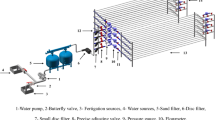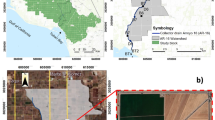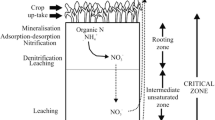Abstract
Emitter clogging risk might be enhanced by the specific fertigation practice when applying saline water. Two stages of on-site drip irrigation experiments applying saline water were conducted to investigate the effects of the phosphorus (P) fertigation and combined P and nitrogen (N) fertigation and the water salinity on emitter clogging when using a plain channel emitter and a labyrinth emitter. During stage one, the water-soluble phosphate fertilizers monoammonium phosphate (MAP), diammonium phosphate (DAP), and urea phosphate (UP) were tested in comparison with a control treatment without fertigation (CK). During stage two, four combined P and N fertigation practices were tested by mixing one phosphate fertilizer (MAP or DAP) with one N fertilizer (urea (U) or ammonium sulphate (AS)). Four levels of water electrical conductivity measuring about 0.5 (groundwater, G), 2 (S2), 4 (S4), and 6 (S6) dS m−1 were tested at both experimental stages. The discharge rates of the emitters were measured following every other two fertigation events during stage one and following each fertigation event for stage two. At the end of the experiments, several representative emitters were sampled to measure the dry weight and the chemical constituents of the clogging substances in the emitters. The results demonstrated that the P fertigation with a weak or a slightly stronger acidic fertilizer such as MAP or UP reduced the emitter clogging effectively during groundwater application. For saline water application, the emitter clogging clearly increased with the water electrical conductivity. Phosphorus-coupled nitrogen fertigation accelerated the precipitation of phosphate sediments greatly when either groundwater or saline water was applied. In fact, the precipitation of phosphate sediments exceeded 80% of the dry weight in the emitters under saline water irrigation. Rapid development of emitter clogging occurred for both types of emitters when saline water with electrical conductivity higher than 4 dS m−1 was applied under phosphorus-coupled nitrogen fertigation. The phosphorus-coupled nitrogen drip fertigation should be applied with cautious when applying saline water with electrical conductivity higher than 4 dS m−1. Fertigating with nitrogen fertilizers along with acid phosphate fertilizers together is a promising way to alleviate the emitter clogging caused by the ion components in saline water.










Similar content being viewed by others
References
Aali KA, Liaghat A, Dehghanisanij H (2009) The effect of acidification and magnetic field on emitter clogging under saline water application. J Agric Sci 1(1):132–141
Alon BG, Dudley LM (2003) Phosphorus availability under continuous point source irrigation. Soil Sci Soc Am J 67(5):1449–1456
ASAE (2003a) S553: collapsible emitting hose (drip tape)—specifications and performance testing. ASAE, Detroit
ASAE (2003b) EP4051: design and installation of microirrigation systems. ASAE, Detroit
Beltrán JM (1999) Irrigation with saline water: benefits and environmental impact. Agric Water Manag 40(2–3):183–194
Bozkurt S, Ozekici B (2006) The effects of fertigation managements on clogging of in-line emitters. J Appl Sci 6(15):3026–3034
Bucks DA, Nakayama FS, Gilbert RG (1979) Trickle irrigation water quality and preventive maintenance. Agric Water Manag 2(2):149–162
Bull HB, Breese K, Ferguson GL, Swenson CA (1964) The pH of urea solutions. Arch Biochem Biophys 104(2):297–304
Capra A, Scicolone B (1998) Water quality and distribution uniformity in drip/trickle irrigation systems. J Agric Eng Res 70(4):355–365
Chen M, Kang YH, Wan SQ, Liu SP (2009) Drip irrigation with saline water for oleic sunflower (Helianthus annuus L.). Agric Water Manag 96(12):1766–1772
Hanson B, Hopmans JW, Šimůnek J (2008) Leaching with subsurface drip irrigation under saline, shallow groundwater conditions. Vadose Zone J 7(2):786–799
Hao F, Li J, Wang Z, Li Y (2017) Effect of ions on clogging and biofilm formation in drip emitters applying secondary sewage effluent. Irrig Drain 66:687–698
Hao F, Li J, Wang Z, Li Y (2018) Effect of chlorination and acidification on clogging and biofilm formation in drip emitters applying secondary sewage effluent. Trans ASABE 61:1351–1363
Haynes RJ (1985) Principles of fertilizer use for trickle irrigated crops. Nutr Cycl Agroecosyst 6(3):235–255
Hills D, Nawar F, Waller P (1989) Effects of chemical clogging on drip-tape irrigation uniformity. Trans ASAE 32:1202–1206
Keller J, Bliesner RD (eds) (1990) Sprinkle and trickle irrigation. Van Nostrand Reinhold, New York, pp 463–465
Lamm FR, Ayars JE, Nakayama FS (2007) Microirrigation for crop production: design, operation and management. Elsevier, Amsterdam
Li J, Zhang J, Rao M (2004) Wetting patterns and nitrogen distributions as affected by fertigation strategies from a surface point source. Agric Water Manag 67:89–104
Li J, Chen L, Li Y (2009) Comparison of clogging in drip emitters during application of sewage effluent and groundwater. Trans ASABE 52(4):1203–1211
Li Y, Zhou B, Liu Y, Jiang Y, Pei Y, Shi Z (2013) Preliminary surface topographical characteristics of biofilms attached on drip irrigation emitters using reclaimed water. Irrig Sci 31(4):557–574
Li K, Niu W, Zhang R, Liu L (2015a) Accelerative effect of fertigation on emitter clogging by muddy water irrigation. Trans CSAE 31(17):81–90 (in Chinese with English abstract)
Li X, Kang Y, Wan S, Chen X, Chu L (2015b) Reclamation of very heavy coastal saline soil using drip-irrigation with saline water on salt-sensitive plants. Soil Till Res 146:159–173
Li J, Gao Y, Zhang X, Tian P, Li J, Tian Y (2019) Comprehensive comparison of different saline water irrigation strategies for tomato production: soil properties, plant growth, fruit yield and fruit quality. Agric Water Manag 213:521–533
Liu L, Niu W, Wu Z, Guan Y, Li Y (2017) Risk and inducing mechanism of acceleration emitter clogging with fertigation through drip irrigation systems. Trans CSAM 48:228–236 (in Chinese with English abstract)
Liu L, Niu W, Guan Y, Wu Z, Ayantobo OO (2019) Effects of urea fertigation on emitter clogging in drip irrigation system with muddy water. J Irrig Drain Eng 145(9):04019020
Malash N, Flowers TJ, Ragab R (2005) Effect of irrigation system and water management practices using saline and non-saline water on tomato production. Agric Water Manag 78:25–38
Mikkelsen RL (1989) Phosphorus fertilization through drip irrigation. J Prod Agric 2(3):279–286
Nakayama FS, Bucks DA (1991) Water-quality in drip/trickle irrigation—a review. Irrig Sci 12(4):187–192
Niu W, Liu L, Chen X (2012) Influence of fine particle size and concentration on the clogging of labyrinth emitters. Irrig Sci 31(4):545–555
Oron G, DeMalach Y, Gillerman L, David I, Lurie S (2002) SW—soil and water: effect of water salinity and irrigation technology on yield and quality of pears. Biosyst Eng 81(2):237–247
Pasternak D, DeMalach Y (1995) Irrigation with brackish water under desert conditions X irrigation management of tomatoes (Lycopersicon esculentum Mills) on desert sand dunes. Agric Water Manag 28(2):121–132
Pei Y, Li Y, Liu Y, Zhou B, Shi Z, Jiang Y (2014) Eight emitters clogging characteristics and its suitability under on-site reclaimed water drip irrigation. Irrig Sci 32(2):141–157
Sagi G (1990) Water quality and clogging of irrigation systems in Israel in 1989. Water Irrig Bull 280:57–61
Song P, Li Y, Zhou B, Zhou C, Zhang Z, Li J (2017) Controlling mechanism of chlorination on emitter bio-clogging for drip irrigation using reclaimed water. Agric Water Manag 184:36–45
Tarchitzky J, Rimon A, Kenig E, Dosoretz CG, Chen Y (2013) Biological and chemical fouling in drip irrigation systems utilizing treated waste water. Irrig Sci 31(6):1277–1288
Wu X, Wu W, Liu H, Hao Z, Ma Z (2008) Experimental study on anti-clogging performance of emitters for reclaimed wastewater irrigation. Trans CSAE 24(5):61–64 (in Chinese with English abstract)
Yuan Z, Waller PM, Choi CY (1998) Effects of organic acids on salt precipitation in drip emitters and soil. Trans ASAE 41(6):1689–1696
Zhangzhong L, Yang P, Ren S, Li Y, Liu Y, Xia Y (2016) Chemical clogging of emitters and evaluation of their suitability for saline water drip irrigation. Irrig Drain 65(4):439–450
Zhangzhong L, Yang P, Zhen W, Zhang X, Wang C (2019) A kinetic model for the chemical clogging of drip irrigation system using saline water. Agric Water Manag 223:105696
Zhou B, Li Y, Pei Y, Liu Y, Zhang Z, Jiang Y (2013) Quantitative relationship between biofilms components and emitter clogging under reclaimed water drip irrigation. Irrig Sci 31(6):1251–1263
Zhou H, Li Y, Xiao Y, Liu Z (2019) Different operation patterns on mineral components of emitters clogging substances in drip phosphorus fertigation system. Irrig Sci 37(6):691–707
Acknowledgements
We are grateful for financial support from the National Natural Science Foundation of China (51790531), the National Key Research and Development Project of China (2016YFC0403103), and the Foundation of State Key Laboratory of Simulation and Regulation of Water Cycle in River Basin (SKL2018TS06).
Author information
Authors and Affiliations
Corresponding author
Ethics declarations
Conflict of interests
On behalf of all authors, the corresponding author states that there is no conflict of interests.
Additional information
Publisher's Note
Springer Nature remains neutral with regard to jurisdictional claims in published maps and institutional affiliations.
Rights and permissions
About this article
Cite this article
Wang, Z., Yang, X. & Li, J. Effect of phosphorus-coupled nitrogen fertigation on clogging in drip emitters when applying saline water. Irrig Sci 38, 337–351 (2020). https://doi.org/10.1007/s00271-020-00675-2
Received:
Accepted:
Published:
Issue Date:
DOI: https://doi.org/10.1007/s00271-020-00675-2




